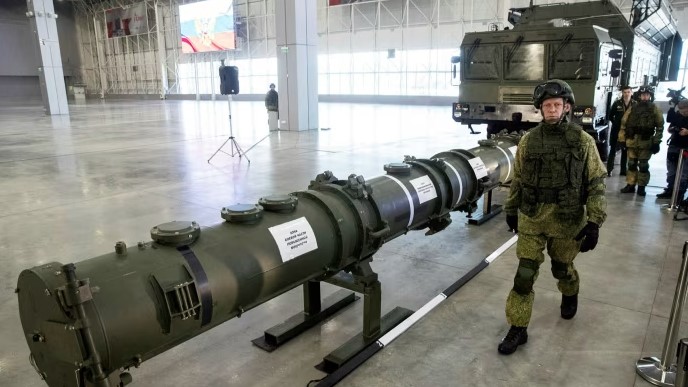Russia has reportedly used the 9M729 cruise missile, a weapon surrounded by global controversy, in its recent attacks on Ukraine. The 9M729 is a ground-launched cruise missile capable of carrying both conventional and nuclear warheads. Its range is believed to exceed 2,500 kilometers, making it capable of striking targets across vast distances.
Rising Concerns Over Russia’s 9M729 Missile Deployment
This missile is not new to international scrutiny. Its secretive development years ago raised alarm among Western nations and ultimately contributed to the end of a major arms control agreement between two superpowers.
The United States had accused Russia of violating the terms of the Intermediate-Range Nuclear Forces (INF) Treaty, which banned land-based missiles with ranges between 500 and 5,500 kilometers. Following these accusations, the U.S. withdrew from the treaty in 2019, citing non-compliance related to this missile.
Ukraine has now confirmed multiple uses of the 9M729 missile in the ongoing conflict. According to Kyiv’s defense records, the missile has been launched 23 times since August. This repeated use marks a worrying development in the war, intensifying both military and diplomatic tensions in the region.
The 9M729 missile’s deployment comes at a time when the global community is already concerned about the rising use of advanced long-range weapons in active conflict zones. These missiles, with their extended range and destructive potential, have the ability to hit critical infrastructure deep inside a country, posing a major risk to civilian and military targets alike.
The History Behind the 9M729 Missile
Russia developed the 9M729, known in NATO classification as SSC-8, as part of its advanced missile modernization program. The missile forms a land-based version of the Kalibr cruise missile family and launches from mobile ground platforms. Its design enables it to carry different types of warheads, including nuclear ones, depending on mission requirements.
International observers find the 9M729 especially concerning because of its potential range. Russian defense authorities claim the missile’s range stays within treaty limits, but Western experts argue that it actually exceeds the range permitted under the INF Treaty, thus violating the agreement’s terms.
Fueling the frontlines — Ukraine’s drone assaults cripple 20% of Russia’s oil capacity
This dispute over the missile’s capabilities created years of diplomatic tension. The United States accused Russia of secretly testing and deploying the missile in violation of the treaty’s rules. Moscow repeatedly denied the allegations, but both sides failed to resolve the issue. The growing distrust between the two nations eventually caused the treaty to collapse in 2019, ending decades of arms control cooperation that had stabilized post–Cold War Europe.
The 9M729 controversy continued even after the treaty ended. Analysts have tracked Russia’s ongoing development and deployment of the missile. Reports indicate that Russia has stationed launch units across several military districts, giving the missile the ability to reach targets throughout Europe and beyond. The missile’s mobility also makes it difficult to detect and intercept, adding to security concerns among neighboring countries.
Escalation and International Reaction
The renewed use of Russia’s 9M729 cruise missile in Ukraine has sparked strong reactions from international observers. Defense experts warn that the missile’s deployment poses risks not only to Ukraine but to the entire European region. Its long range allows it to strike deep into enemy territory, shifting the military balance and raising fears of wider escalation.
Ukraine has urged global powers to pressure Russia to stop its missile attacks, reporting heavy damage to infrastructure and growing civilian hardships. The missile’s nuclear capability adds to concerns about its use in active warfare.
While Russia’s Defense Ministry has not commented, recent operations suggest an increased reliance on advanced ballistic and cruise missiles. These developments have reignited security debates within NATO and among European defense analysts.
Russia’s S-400 turns into Turkey’s headache—airpower crisis mounts as F-35 ban persists
The situation recalls the Cold War era, when similar weapons were central to global disarmament talks. The 9M729’s modern design—combining long range, precision, and mobility—makes it both a powerful weapon and a source of instability.
Experts note that its reappearance underscores the weakening of global arms control systems. Without treaties like the INF, there are fewer safeguards to limit such weapons, heightening the risk of further military escalation across Europe.

